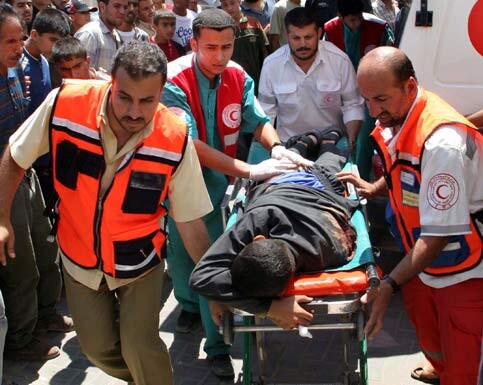Shouka, Gaza Strip 14 August 2006

A wounded Palestinian is carried to a hospital after an Israeli air strike on Rafah refugee camp, southern Gaza Strip, 3 August 2006. (MaanImages/Hatem Omar)
Located in the furthest reaches of eastern Rafah city, in the southernmost part of Gaza Strip, lies the village of Shouka, population 14,000. Reaching the village at night time is difficult for strangers, as taxi drivers decline to take people there.
It was almost night time when the driver took me to the nearest place, the Salah Eldin Road, eastern Rafah. I got out of his taxi, looking for another driver, Awni, a local Shouka resident and driver who is aware of every single corner in Shouka, and we began our drive through dusty roads and trees.
Torn water pipes of green houses, scattered bricks and cut trees were lying everywhere en route to the village’s mayor, Mansour Braika. But we managed to reach the mayor’s house, and asked him about the Israeli occupation army invasion of Shouka that lasted over a month, until the army finally pulled out of Shouka on August 2.
“Silence, mixed with battered farms and destroyed houses, have been the main features of our small village since the Israeli forces left 10 days ago”.
Mayor Mansour pointed out that “for more than 40 days, the Shouka rural area has been under Israeli attack, as the Israeli tanks have been firing, by day and night, on the people’s houses and farms.”
“The damages are immense; 129 green houses have been destroyed, 58 houses were torn down, while many of our village’s inhabitants have been evacuated to safe shelters at local UNRWA [United Nations Refugee and Works Agency] schools. The water networks in the village have been totally destroyed. Shouka is a traumatized village”, Mayor Mansour confirmed.
The Mayor refuted Israeli allegations that the village is used for launching home-made rockets on Israeli territory.
“This is a rural area, where families are bound by tribal connections; no strangers can enter at night time, therefore, we are refuting the Israeli side’s allegations that the area is used for launching rockets. The farmers here are protecting their livelihoods. We don’t have any strangers in the village — resistance forces, thieves, or anyone”.
Twenty-six-year-old local farmer Toufic Albraikat, described the destruction he has suffered. “Two thousand square meters of green houses plus 4,000 square meters of electronically-irrigated garlic crops, plus nine sheep and 2,000 bricks, as well as a barbed-wire fence around my land, all have been destroyed by the Israeli tanks”.
We drove back from the village on our way to the main local Rafah hospital of Abu Yousef Alnajjar, where Dr. Ali Mousa, the hospital’s director was waiting to talk of the human losses the Shouka village has suffered in the latest Israeli attack.
“The last invasion of Shouka by the Israeli military forces resulted in a total of 17 dead, 50 injured. Around 25 of the dead and injured are children under the age of 15. We found that in this attack that the Israeli forces used a new weapon, as most or even all of the dead received by the hospital had been shot by missiles and tank bombs. The bodies of the victims had been torn apart, covered with burns. Fifteen of the wounded are in critical condition, having each had at least one limb amputated.”
“We have never seen these types of injuries before in the past six years of open conflict. Here we are unable to diagnose the nature of these injuries due to the severe lack of specialized medical centers, but we are sure that this is an illegal weapon. Therefore, we call on all international institutions and the United Nations to examine this type of weapon, which is being used for the first time in Palestine”.
In Gaza City, the next day, Silvia Pevetti, of the Gaza-based Office of World Health Organization, said that her organization is gathering information on the issue of banned weaponry, after having received an official request from the Palestinian government, but has not issued a report as of yet.
Graciela Lopez, Acting Head of Gaza Sub-delegation of the International Committee of the Red Cross said: “In general, we are here to remind the warring parties of their obligations under International Humanitarian Law to respect the civilian populations at all times and to make all possible distinctions between persons directly involved in the hostilities and the civilian population.”
Asked about possible Israeli use of illegal weapons against the Palestinian population in Gaza, Lopez maintained: “We are in contact with hospitals and with the Palestinian Red Crescent Societies, working in the medical field, and it is our concern to follow up on these allegations of the use of a new type of weapons. At this moment, we cannot confirm the use of any particular type of new weapon. We are following the situation and take these allegations seriously”.
According to the latest Palestinian Health Ministry reports, since the June 26 military attack codenamed ‘Summer Rains’ has begun, the Israeli occupation army has killed 203 Palestinians, including 58 children and 25 women, and wounded 783 others, including 281 children, and 86 women. Seventy-two of the injured have had limbs amputated.
Since June 27, the Israeli occupation army has waged a massive military operation across the Gaza Strip for the purpose of liberating a soldier of its own, who was held in an unprecedented Palestinian resistance attack on a military base, south of Gaza Strip. The operation has resulted in a widespread destruction of Gaza’s infrastructure including the main power plant, ministerial buildings, bridges, houses and farms.
Related Links
Rami Almeghari is currently a Senior Translator at the Translation Department of the Gaza-based State Information Service (SIS) and former Editor in Chief of the SIS-linked International Press Center’s English site. He can be contacted at rami_almeghari@hotmail.com




